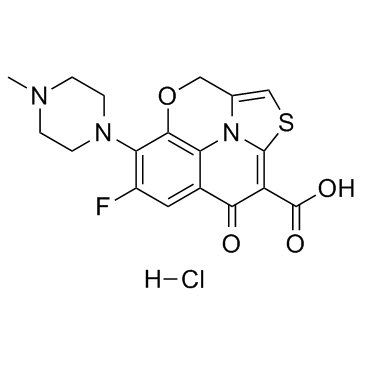119474-55-4
| Name | 9,1-Epoxymethano-7-fluoro-8-(4-methyl-1-piperazinyl)-5-oxo-5H-thiazolo[3,2-a ]quinoline-4-carboxylic acid hydrochloride |
|---|---|
| Synonyms |
9,1-(epoxymethano)-7-fluoro-8-(4-methyl-1-piperazinyl)-5-oxo-5H-thiazolo[3,2-a]quinoline-4-carboxylic acid hydrochloride
6-Fluoro-5-(4-methyl-piperazin-1-yl)-8-oxo-3H,8H-4-oxa-1-thia-9b-aza-cyclopenta[cd]phenalene-9-carboxylic acid hydrochloride 9,1-epoxymethano-7-fluoro-8-(4-methyl-1-piperazinyl)-5-oxo-5H-thiazolo[3,2-a]quinoline-4-carboxylic acid hydrochloride KB-5246 |
| Description | KB-5246 is a tetracyclic quinolone and displays antibacterial activities. |
|---|---|
| Related Catalog | |
| Target |
Bacterial[1] |
| In Vitro | KB-5246 is a tetracyclic quinolone and displays antibacterial activities. The MICs for 90% of isolates tested (MIC90s) of KB-5246 against gram-positive microorganisms such as Staphylococcus aureus, including methicillin-resistant S. aureus, Staphylococcus epidermidis, Streptococcus pneumoniae, and Streptococcus pyogenes, are 0.39 μg/mL. KB5246 inhibits 90% of isolates of Escherichia coli, Klebsiella pneumoniae, Klebsiella oxytoca at a concentration of 0.10 μg/mL or less. When a concentration of KB-5246 at the MIC or higher is added, no regrowth after 24 h of incubation is observed[1]. |
| In Vivo | The 50% effective dose values of KB-5246 against S. pneumoniae 2132 infections are 50.5 mg/kg of body weight. The activities of KB-5246 against S. aureus Smith, P. aeruginosa GN11189, and Serratia marcescens GN7577 infections are comparable to those of ofloxacin and greater than those of norfloxacin[1]. |
| Cell Assay | Bactericidal activity is tested by evaluating the reduction of viable cells during exposure to KB-5246 for 24 h. An overnight culture of microorganisms in sensitivity test broth is diluted to about 104 CFU/mL in the same medium and incubated at 37°C on a shaker. After 2 h of incubation, KB-5246 is added to the cultures at final concentrations of one half, one, two, or four times the MIC[1]. |
| Animal Admin | In vivo antibacterial activity against systemic infections in mice is determined. Ten male ddY mice weighing 19 to 23 g each are used for each dose level. An overnight culture in brain heart infusion broth at 37°C is diluted appropriately in the same medium with 4% gastrin mucin. A 0.2 mL sample of a bacterial suspension, corresponding to a dose 1 to 25 times higher than the minimal lethal dose, is injected intraperitoneally. Immediately after infection, mice are treated orally with a single dose of KB-5246. The number of mice surviving at each dose is counted 7 days after infection. The 50% effective dose is calculated by the probit method[1]. |
| References |
| Molecular Formula | C18H17ClFN3O4S |
|---|---|
| Molecular Weight | 425.86200 |
| Exact Mass | 425.06100 |
| PSA | 102.73000 |
| LogP | 2.80060 |
| Storage condition | 2-8℃ |
